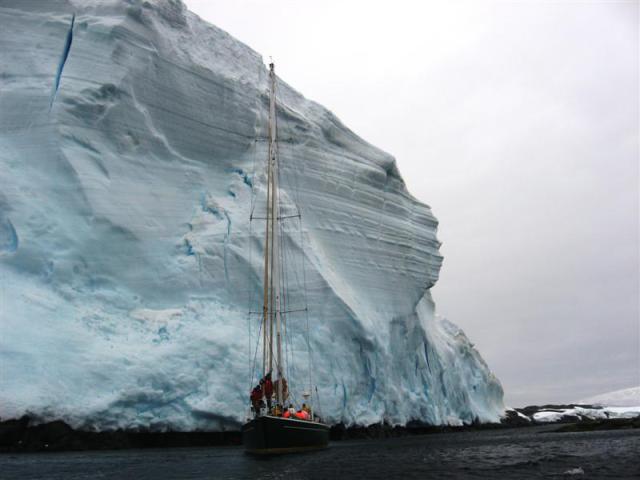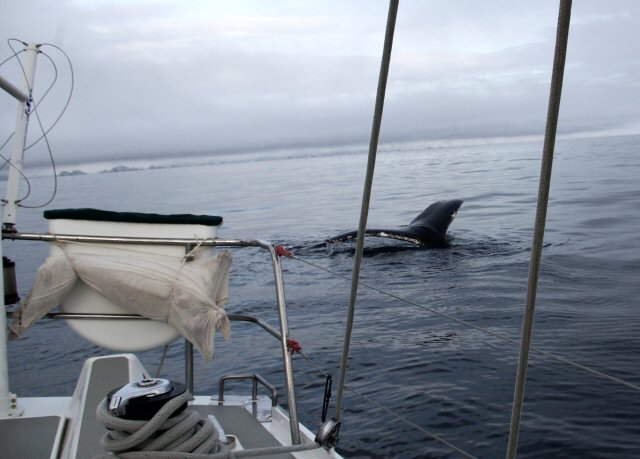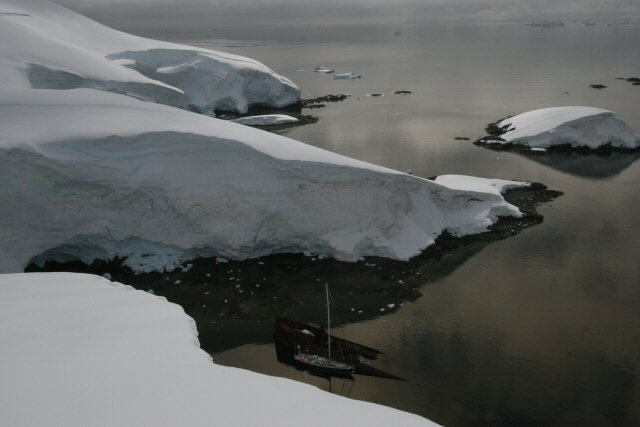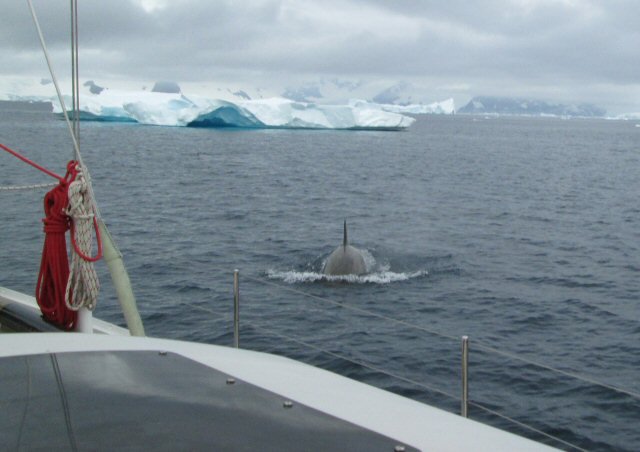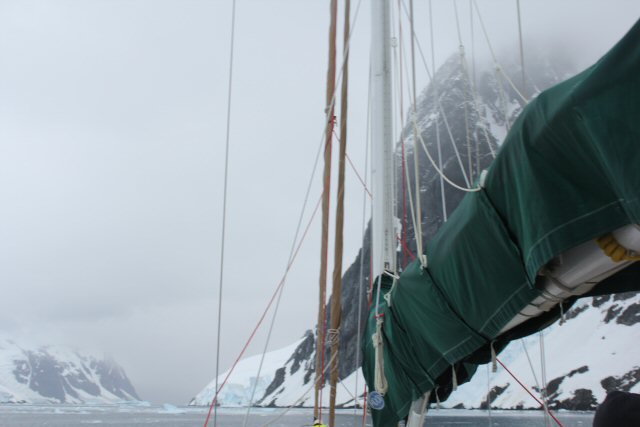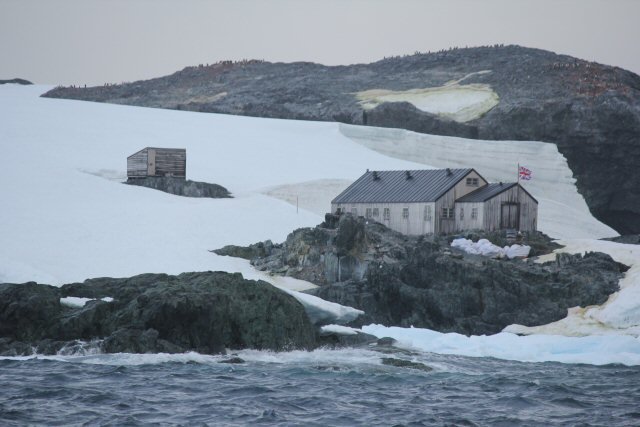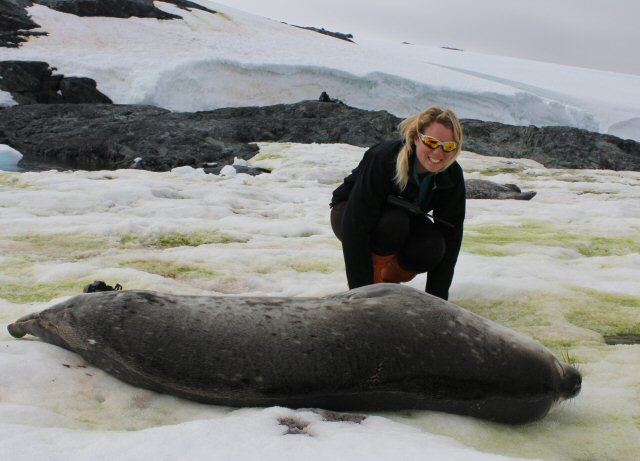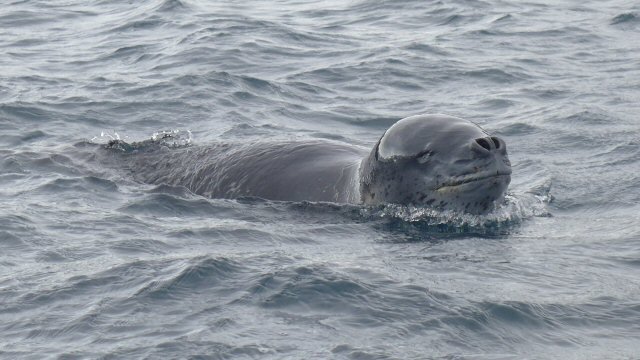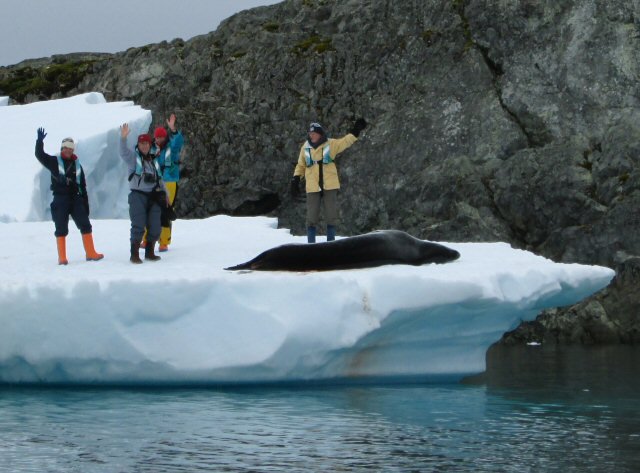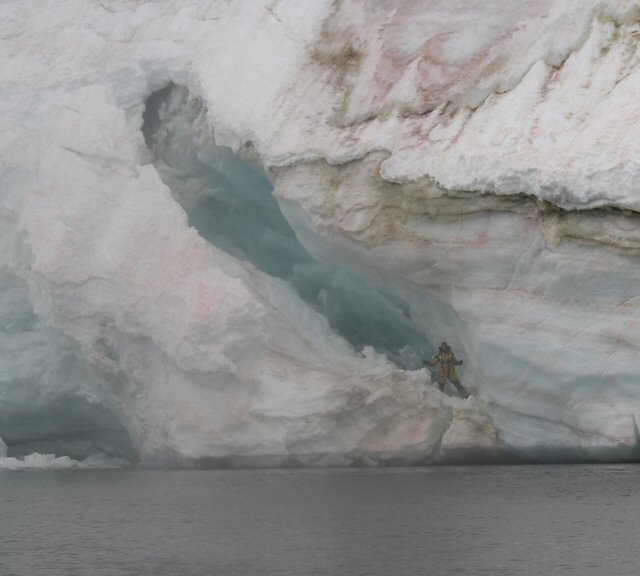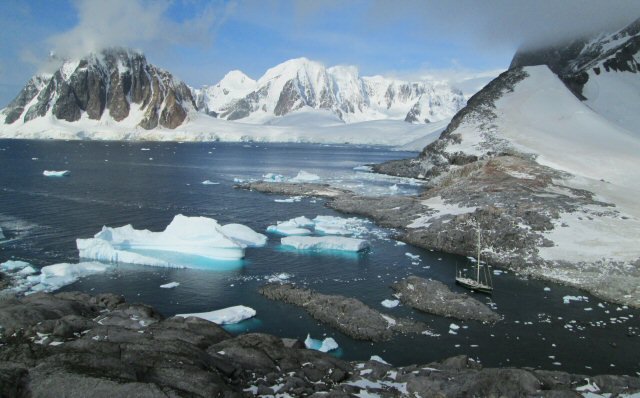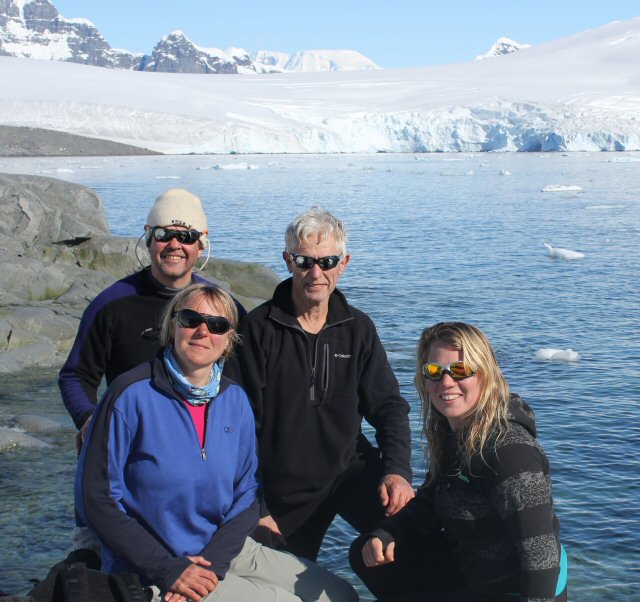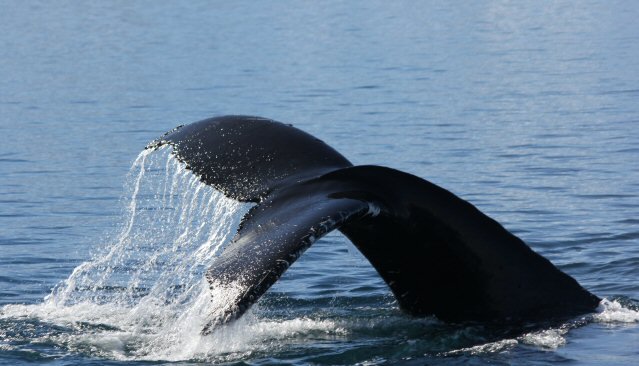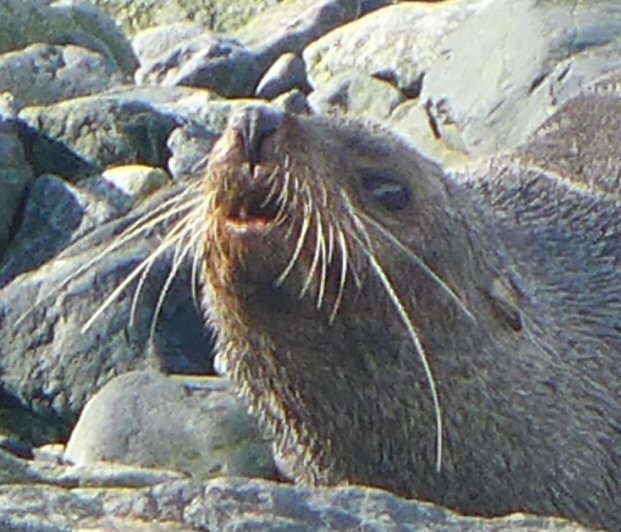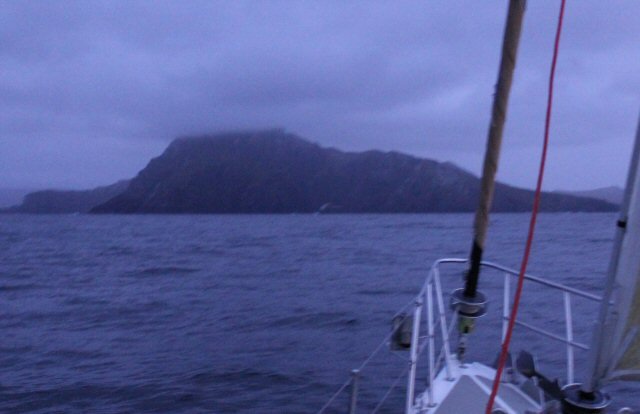Seven of us are on board Xplore and waiting to go. The weather is not what we would like, so we will stay in port for now and probably leave Ushuaia after midnight.
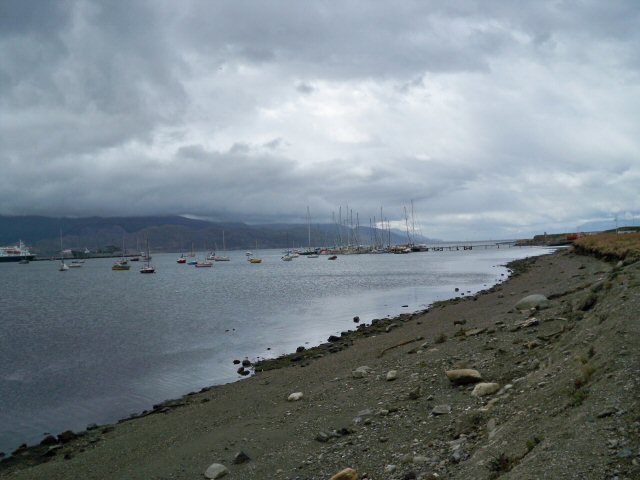
Antarctica Tuesday?
We sailed out of Ushuaia Saturday morning. Dozens of Dolphins escorted us down the Beagle Channel. Julian took this picture. At this time we are are trying to make our best speed to the south running between two large low pressure systems. There are seven of us on board Xplore, a very good group. I am certain we will have a great time.
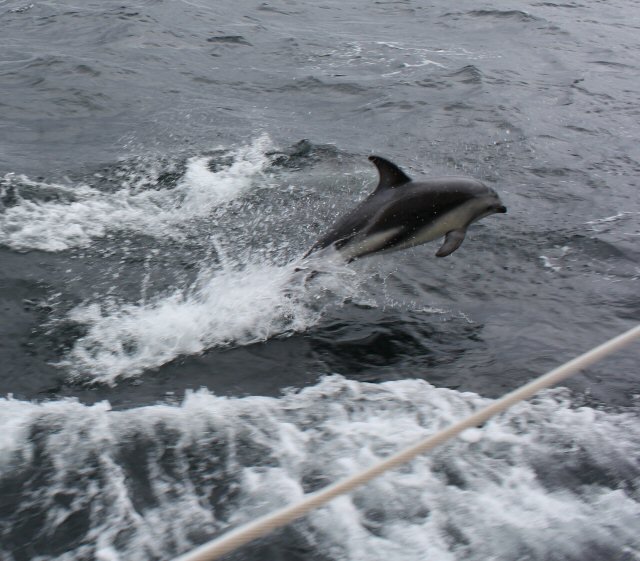
In Antarctica
We have arrived in Antarctica! After four days and 700 nautical miles this morning we completed our voyage from Ushuaia eastwards along the Beagle Channel and then just east of south across Drake’s Passage to the Antarctic Peninsular . For all seven of Xplore’s crew- skipper Stephen, mate Debbie and working guests Richard,Julian, Ellen, George and second Richard from England – the trip was challenging in a variety of different ways. We encountered two periods of strong winds, one with gusts of 50 knots the other of 40 knots, blowing dogs of chains as they say in Oz, with the crew muttering, ‘Ah mateys, them that dies will be the lucky ones’. The seas were to match and limited visibility in the middle of the trip when we needed to be on close look out for icebergs and growlers added to the excitement. We soldiered on and this morning, as dawn was breaking under a crescent moon we entered the bay leading to the Melchior Island. Proceeding south towards our chosen landfall on Enterprise Island, we saw whales, penguins, seals and a variety of Antarctic birds including tern and the occasional albatross. The rising sun glinted on the peaks, escarpments and snowfields of Brabant Island to our north. Stephen had chosen as a safe and interesting mooring to lie alongside a 100 year old wrecked Norwegian whaler. After a very disciplined lunch (we decided to keep the wine mostly for supper this evening) we launched the Zodiac dinghy to explore our new surroundings. A landing on what Richard L has christened Carter Island (official application shortly to be lodged) revealed 8 seals which we admired but made a cautious retreat. We also saw penguins swimming, climbing up hills and sunning themselves. A small party climbed a snowy hill and built a snowman which we named Mr Antarctica. Safely aboard Xplore we look forward to a wonderful supper and more adventures. Do look at Ellen’s photograph of the humpbacks that welcomed us this morning to the Antarctic Peninsula. It also shows Baabaaraa lashed to the rail, a lamb of course! We are all very excited to be here. We can hardly believe what we are seeing and our good fortune to be here all together.
Written by “The Crew of Xplore”
Enterprise Island
Another interesting and exciting day. We split into two groups ,to explore the lands and seas around Enterprise Island, where our ship Xplore is moored. The first group of Richard, Debbie and George headed east across the sound to seek the mainland of the Antarctic Peninsular. Using the Zodiac dinghy good progress was made, the group landing on a rocky beach three miles due east of Enterprise,Icarus Point. Richard upheld Boston’s honour by being the first to set foot on the mainland.George upheld the standing of Australia and Czechoslovakia and was second ashore. There was a bit of unexpected excitement when an ice fall crashed onto the beach not far from Debbie who made a quick and safe exit. No flying too close for her! The second group led by Stephen donned ice shoes to climb the slopes behind the boat reaching a height of about 400 feet above sea level. The work was hard but enjoyable. The view to the east, north and west extended to over 40 miles- quite fantastic except of course that it was real! Do look at the photo of Xplore taken from the point above the boat. The return included some butt sliding down the hill; Julian won the prize for the fastest descent. Tomorrow Xplore heads south again, and a new anchorage at the end of the day.
From Team Xplore.
You may email us with questions or comments at richard@icetent.com
Nature in the Raw
Picture is of a Killer Whale that passed under Xplore
Under a cold and moody early morning sky we left Enterprise island heading south between Nansen and Brooklyn Islands toward the Antarctic Circle. This is an elemental place where majestic beauty and survival live together. None brings reality for seals, penguins and other unfortunates more into focus than the killer whale. A calculating creature , the killer is nature’s ultimate enforcer in the south. Today we saw several at work: the photos show one aiming at Explore and its power after diving under the boat. We escaped. Were the seals so fortunate…..? Some will have perished, certainly. Tomorrow we will tell you about life on Lautaro Island at almost 65 degrees south,where we moored at 7 pm tonight,after rigging rock cables and four long mooring lines.
Team Explore.
Our email richard@icetent.com
To Infinity and Beyond
Today Ellen and I went for a cruise in the Zodiac dingy to explore this part of Antarctica. We soon found a Celebrity Cruise Ship named Infinity. We approached close to the ship where hundreds of passengers stood along the rail probably wondering where on earth we came from in our tiny boat. See attached photo of the ship.
.
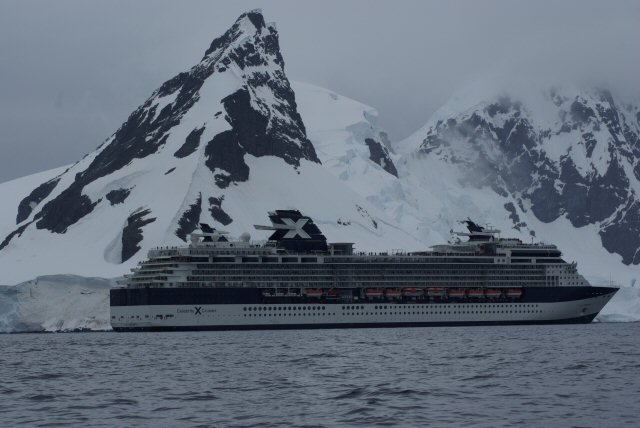
Celebrity Cruise Ship Infinity
Mooring in Antarctica
Attached is a photo showing our mooring at Lautaro Island. Explore is moored with four lines, two from the bow and two the stern onto steel cables looped around rocks on the shore. These were placed by Stephen and Richard T using the Zodiac and a little rock climbing.
The forecast looks good and so tomorrow we will head south again aiming for the Antarctic Circle at 67 degrees south. Stay tuned!
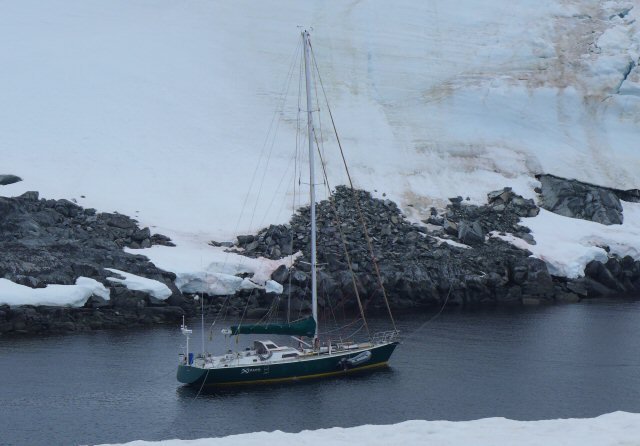
Lautaro Island
Through Lemaire Strait to Mutton Cove Island
Early on Saturday 10 February we left our inlet mooring on Lautarro Island to push on south toward Mutton Cove Island, at 66 degrees south almost at the edge of the Antarctic Circle, beyond which in the austral summer the sun never sets. To do so, however, Xplore had to pass safely through the narrow and berg strewn Lemaire Strait. Under a low, grey sky we ventured forth guided by Stephen, our skipper, and the only one to have passed this way before. The photo gives an idea of this narrow path of water-high mountains and ice on each side and bergs and growlers to be safely passed. At times we slowed our boat to 2 knots to avoid running into ice. A big piece could damage Xplore so safety was the only priority. As we cleared the south end of the strait we left mountains Scott and Shackleton- named after the celebrated Antarctic explorers on our east side and pressed on south under the Yankee sail and motor.
The total distance to Mutton was over 95 miles. Traveling at seven knots, we had many hours still to run. Watches on deck in the cold provided time to appreciate the extent and variety of Antarctica’s sights and creatures. Finally, at almost 11 pm we closed in on Mutton Cove only for the wind to become frisky and a snow blizzard to reduce visibility. Our work was not finished. For an hour one team in the Zodiac dinghy laid rock strops to the rocks of the cove and the other held the boat steady in the strong wind and anchored. By midnight we were safely moored, 16 hours after starting our journey. We celebrated with cheese, biscuits and red wine around the table of Xplore’s wardroom and deep sleeps all round.
Tomorrow, deo volante, we will reach 66 degrees 33 minutes south, the line of the Antarctic Circle.
Team Explore.
Arrival at Detaille Island
Today, Monday 11 February was special for Team Xplore- we crossed the line into the Antarctic Circle eleven days after leaving Ushuaia and broke new ground in mooring in an un-surveyed and potentially treacherous cove on Detaille Island. Mooring here requires great care and skill; a mistake would leave the boat damaged many hundreds of miles from support. This is the base of one of the old British research stations now being restored. The photo shows the station proudly flying the Union Jack. We met the restoration team who leave tomorrow after a season of work; they kindly showed us round. Inside the hut you see how they lived and what they did. A fascinating historic record of an important part of all our pasts. If you want to support the work please visit http://www.ukaht.org which is site of the Antarctic Heritage Trust.
Tomorrow we head north to Watkins Islands to find a safe haven in which to shelter from a strong gale which is forecast.
Team Xplore
Whispering with the seal
On Tuesday morning before leaving Detaille Island we had a last run ashore and saw no less than 17 seals dozing on the ice. Debbi, the first mate of Xplore, made special friends with this Weddell seal. No doubt he benefited from her encouragement. Interestingly, only one Penguin was about…maybe the seals had something to do with this?
By noon we were at sea again heading north and leaving the Golden Circle bound for the Argentine Islands. On the voyage north we enjoyed bright sun which glinted on the mountains of Graham Land to the East, before the mist and fog of an Antarctic night enveloped us. We arrived at the islands at 65 degree south shortly after dawn. Safely moored by ropes from each corner of the boat, Ellen had to scramble 50 feet up a shaling rock face to place the wire strops- and with the anchor down, we are well placed to ride out the forecast stormy weather. In the coming days we plan to explore the islands by Zodiac, including Full Astern Rock, whose name we will be researching. More to follow..
Team Xplore
Feel free to send questions or comments to richard@icetent.com
Emma
The Leopard- masters of sea, ice and land
Moored in our inlet on the west side of Galindez Island we have been treated to the power and playfulness of the leopard seal, equally impressive on land, ice flow and at sea. Massive and agile, the Leopard can be deceptive, dozing on a flow one moment, the next twisting, rising and diving as it plays or hunts in the water. Here are four of us from Xplore sharing a moment on her flow with a leopard we named Emma. Fortunately she had already fed well! The second photo shows another Leopard after diving under the Zodiac and emerging to see where we were. This play went on for at least five minutes leaving us happy to have shared these moments in nature.
This morning, Thursday 14 Feb, we visited the Ukrainian researchers at the Vernadsky station on Galindez Island. Friendly and hospitable, the team maintain the traditions of the base, including dressing for dinner on Saturdays. They took over from the British in 1996. It was here at the Faraday Base, as it was then known, that the Ozone hole was first identified in about 1960. Galindez is a palace of beauty and science. Its a privilege to be here. Warmed with locally brewed vodka from our Ukrainian friends, we visited Wordie Hut- recently restored by the UK Antarctic Heritage Trust. The original research station here, the Hut shows the harsh life men lived to be able to improve man’s understanding of meteorology and other key sciences.
To the north the wind is blowing cats and dogs but we are sheltered and just about to enjoy our Valentine’s Day feast of roast lamb, vegetables and red wine!
Bon appetit to you all, where ever you may be.
Team Xplore
Hovgaard
Xplore has taken shelter at Hovgaard Island to ride out the forecast strong south westerly winds .In a break in the weather, our Dutch- US team of Ellen and Richard L attempted to reach the summit of the island , about one thousand feet above the icy Antarctic sea. Good progress was made but deep and wide crevasses blocked the way, as the photo shows, so the team had to retrace their steps. Meanwhile the Zodiac crew researched the entrance to Lemaire, taking care not to be flipped over by strong katabatic winds coming off the ice and rock cliffs which form the entrance to the strait.On their return they spotted a splendid Weddell seal enjoying the sun on a rock.
We were joined for supper by a young French family from the yacht Petit Prince, who have been voyaging for nine years and full of plans for further voyaging. They plan to winter this year in Ushuaia before exploring the Pacific next. Whilst Stephen and the parents Frank and Maya discussed potential routes and weather patterns, Richard T and Debbie kept young Titouan and Anna entertained, if not always completely under control, as they raced around the benches of the wardroom table and used Xplore’s crew as horses! These youngsters may be receiving an unconventional education but think of the stock of experiences and images they will have and the repertoire of stories for the future…
A further attempt on the summit may be made. Stayed posted.
Team Xplore.
Saturday in Hovgaard
In the south we don’t have days off, but then every day can be dangerous or magical. The rapidity of change in the conditions means that often we experience both. We travel in relative luxury- a 67 feet steel hulled ship with substantial reserves of fuel and equipment on a one month voyage-compared with our new friends from the 40 foot Petit Prince who are nine years into their Odyssey around the world. Frank and Maya from La Trinite sur Mer and Strasbourg left behind careers in the French space industry to pursue a new life afloat. Along the way they were joined by Titouan and Anna , now six and five, voyagers for all of their short lives.The vessel is their transport, home and school. The family have spent the austral summer in Antarctica; soon they will return to Puerto Williams and Ushuaia, where they will winter, skiing, schooling the children and dreaming and planning for the next stage, into the Pacific. We have exchanged home and away evenings aboard our little ships and hope to meet again in Ushuaia, once we have both crossed the 600 hundred miles north across Drake’s Passage and past Cape Horn.
During the day one party from Xplore found and explored the ice cave in the photo; their return they were followed closely by a very hungry Leopard seal! A second party made a further attempt on Hovgaard Mountain, reaching within 100 vertical feet of the summit, before the visibility and driving snow ruled out further progress.
Next, we plan the short journey to Port Charcot, named after the celebrated French Antarctic explorer who mapped this area aboard his ship, the Pourqoi Pas. Stay tuned…
Team Xplore

Ice Cave on Pleneau Island
Early Monday morning found Xplore buffeted by stronger than expected winds from the north whipping up the sea and driving the swell, small bergs and brash into the cove in which we are moored. By dawn the entrance to the cove is blocked with stranded icebergs. To add to our concerns at about 8 am one of the stern lines holding us straight on to the wind and waves fails as the incoming ice lifts the line away from rock fixing. The ship swings round and is in danger of being driven ashore. All the crew spring into action: two in the Zodiac to re-attach the rock strop holding the rope to Xplore, whilst on board we winch in the line and keep her off the closing rocks. At one point we touch the sea floor but fortunately there is no damage. After a long, cold struggle we are safely moored again.The work is not over: Stephen and Debbi spend much of the morning fending incoming ice and brash away from the rudder.
With the turn of tide and the long awaited veer in the wind to the south as the depression giving us our weather, including a barometric pressure reading of 962, finally arrives, ice begins to leave the cove. Our anxiety diminishes but does not go away. At the entrance of the cove the big bergs remained firmly grounded, blocking our exit. At least one of the bergs must shake itself free for Xplore to be able escape to the open sea… Tonight the wind is in the south, so the signs are better. We hope to head north again on Wednesday. Meanwhile we will be climbing the ridges of Booth Island and exploring Port Charcot, whose residents include Gentoo Penguins, Leopard and Fur seals, skuas and Antarctic Terns and for a few days the crew of Xplore.
Team Xplore
Escape from Port Charcot
Tuesday,19 February
Well, we thought that the challenge in leaving Port Charcot would be to squeeze between the encroaching ice bergs! What we hadn’t counted on was this hungry Leopard seal! They say pictures don’t lie: as you can see, this Leopard, the most fearsome of Antarctic seals,was keen to cut our ice line. After a lot of shouting he swam away but not before giving us some extraordinary images. If you would like to see more of these photos, visit http://www.icetent.com in a few days time when they will be on the website. The icebergs did clear sufficiently for us to regain the open sea.
Today we had a glorious short voyage north toward Mount Francais, the highest peak on the Antarctic Peninsular, to Port Lockroy , where we will spend two days, visiting the research huts used by the British in the 1950s and 60s and walking the snowfields and rock ridges above the archipelago’s of the islands here. The sky has been clear and the sun warm, casting diamonds of light across the mountains and ice faces along our route. As we passed mountain ridges, cold winds shot across the water onto Xplore to remind us how cold Antarctica can be. Tonight we are safely moored and content in our lot. Last night we had a temperature of more than minus 5 degrees Celsius and a cold, cold wind- altogether elemental; this evening it’s a balmy 3 degrees, though the cockpit has just reported a gust of 30 knots and the windchill takes the breath away. Inside Xplore around our wardroom, its warm and cosy… our supper of a leg of lamb…
Team Xplore
.

Leopard Seal Eating Shore Line
Fun in the south
Wednesday, 20 February
Sharp, clear blue skies shone over Port Lockroy all day. We visited the British hut on Goodie Island before going by Zodiac to Dorian Bay to see another hut under restoration, which in the 1970s supported ski planes which landed on the ridge on the way south to Rothera Station. The bay sparked in the warm antarctic sunshine, whales and seal hunting in the bay. Having climbed the ridge, Julian and Richard T sled down the hill on a plastic sheet. Whilst George and Richard L admired Minke whale, Richard T, Ellen, Julian and Debbie braved the elements and went for a swim off Damoy Point, in what we guesstimated to be 3 degrees celsius (about 38 fahrenheit). Don’t try this at home! Here we are, having dried and dressed in the sun.
After supper we joined the French crew led by Eric on the 80 foot schooner Veiherie , for a late evening and early morning party of songs and good humour. The journey home in the Zodiac under a brilliant sky of stars, with the Southern Cross bright but Orion’s Belt “upside down”, had us breaking through the freezing surface ice of the water. We made it safely back to Xplore, for a contented and deep sleep.
Team Xplore
Whales, whales…
Thursday,21 February
A hope in coming to Antarctica is to see whales. Some seasons are good , others not so; this year is exceptional. On our way north through the brash ice and small bergs which filled the Neumayer Channel and into the open water leading to Melchior islands- our destination- we counted nine whales. Undoubtedly, there were many more we didn’t see. The excitement never palls: the sound and spume often in the far distance of the whale blowing, the cry of “whale sighted”, the sight of the fin and back and then, if you are lucky, the majestic tail rising and falling in the water. Here is one of the images we captured. Species spotted have included humpback, killer, fin, minke- all the big boys, apart from the blue.
We have moored, anchor and four lines as usual, in Andersen Harbour, Eta Island. The islands of the Melchior are named after the letters of the Greek alphabet, so in our travels there is education as well as entertainment. Soon, we will be returning to the open sea to cross Drake’s Passage, toward our destination of Ushuaia, Argentina. We scan the weather pictures and forecasts with special diligence: there is a high pressure over the northern Antarctic peninsular which is giving us fine weather, but conditions can change quickly.
Team Xplore
Last day in Antarctica
Friday, 22 February
Tomorrow we head north across Drake’s Passage toward Ushuaia. Today has been our last, absorbing the sights and sounds of Antarctica. On beaches and headlands we have seen more than twenty seals, stately Weddell’s and frisky Fur seals, of which this is a good example. The rule is that you shouldn’t get closer than thirty feet- good advice.
The forecast is for reasonable weather, so hopefully we will not encounter the 50 knots we saw on the voyage down. Stay posted…
Team Xplore
Mid Passage across the Drake
Sunday 24 February
After lifting anchor and stowing Xplore’s Antarctic gear of heavy mooring lines , the Zodiac dinghy and the anchor below deck, we set course yesterday morning north, north west for Cape Horn, about 580 miles as an albatross might fly. Gusty winds off the mountains were our parting gift from Antarctica, as the land of rock and ice faded slowly in the distance. A true sea breeze soon set in from the south west helping us on our way. Between the South Shetland islands and Antarctic Peninsular the sea depth is shallow, about 250 metres or 800 feet, so with the west setting current meeting the prevailing wind the sea built up , crest and blowing spray atop the ocean swell. The breeze built to a steady 30 knots, gusting to 38 knots at one point. With declining visibility , we took down the mainsail and sailed out at a good pace under the two forward sails, sometimes reefed. Passing from the continental shelf to the deep ocean, with depths of three or more miles reduced the sea and improved the motion of the ship.
Just we before we left, we heard by email that someone from another sailing vessel had fallen into a 20 foot crevasse on Hovgaard and been injured, but fortunately rescued by a climber from a different boat, and was under care. Some of us and our French friends from Petit Prince had been on that hill a few days earlier. The incident is a continuing reminder of the lurking perils of Antarctica and the Southern Ocean, magnified by remoteness.
A long night gave us a Southern Ocean moon, a sighting of probably our last iceberg and easing winds and sea. Shortly after dawn the girls watch ( Debbie, Ellen and Richard T) raised the mainsail, with Xplore responding with a lively seven and a half knots compared with the rather sedate six knots we had slipped into. We head north on a steady, westerly wind, cold but not unpleasant.
By 1500 on Sunday we have reached 60 degrees 30 minutes north, 66 degrees west, with about 320 miles to run to the Horn. Once we have seen the famous cape, weather permitting, we will then turn east up to the entrance to the Beagle Channel, for the final run of some 50 miles to Ushuaia, hopefully late on Tuesday.
All is well aboard, though some rumblings have been heard about a possible shortage of marmalade; the bananas have definitively all gone!
We are in good spirits though the skipper is being given the run around by the heater: no doubt he will knock it into shape.
Team Xplore
Arrival
Posted on February 26, 2013
Tuesday,26 February
At 6:20 am today Xplore passed Cape Horn, 70 hours after leaving Eta Island, Antarctica. A moonlight night had brought up the famous headland, which grew in size as a clear dawn revealed the mass on which sits the lighthouse, warning and welcoming passing seafarers. This photo shows an unusually benign passage. Soon the sea will be a turmoil of breaking crests on a high swell as the forecast deep low pressure with attendant strong winds rolls in from the west. We did not tarry, turning the ship north east for the entrance to the Beagle Channel, Ushuaia and home.
For each of the seven of us making up the crew the particular reasons for being here, our backgrounds, life stories and ages- George with 85 years of wisdom and Debbi at 23 just starting on life’s voyage- may be very different,but we have come together to share the experiences of voyaging to, and within, Antarctica and its sights, wildlife and challenges. We reached Detaille Island at 67 degrees south and some swam in 3 degrees at 65 degrees south. We saw calms, blue skies and warm sun …but also 50 knots of wind , bitter cold and saw ice forming on the surface of the sea around us.
Pride of place goes to the whales, seals, penguins, antarctic tern, albatross, skuas and many more, and to the stark and rugged beauty of the ice and rock mountains and the sounds of Antarctica itself. Men do not own the earth; we share it. In this white world we were visitors, tolerated but required to recognize the remoteness and innate harshness of the land. We discussed many subjects and learned many things about each other, having moments of shared humour and achievement but also some of tension, as is natural within a group.
We will move on richer for our shared experience and full of memories – and with many photos- of our time together beyond the deep south in Antarctica. Hopefully, we will be a little wiser, too.
The photographs of our voyage shown on the site were taken by Richard Laronde, Ellen Loopstra, Julien Hodges and Richard Tolkien, who also wrote the words describing our 26 day voyage.
Our thanks go to Stephen Wilkins , who showed us Antarctica and carried the responsibility of command, assisted by Debbi.
Team Xplore
Cape Horn
The End

